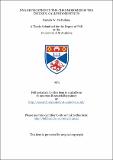Files in this item
DNA replication in the chromosomes of the chicken, callus domesticus
Item metadata
| dc.contributor.advisor | Callan, Harold Garnet | |
| dc.contributor.author | McFarlane, Pamela W. | |
| dc.coverage.spatial | 145 p. | en_US |
| dc.date.accessioned | 2018-06-13T14:39:20Z | |
| dc.date.available | 2018-06-13T14:39:20Z | |
| dc.date.issued | 1974 | |
| dc.identifier.uri | https://hdl.handle.net/10023/14022 | |
| dc.description.abstract | 1. DNA fibre autoradiography has been used to study the replication of chromosomal DNA from chick somatic cells in tissue culture at 37°C, with or without FUdR pre-treatment, and from FUdR-treated chick blastoderm cells. 2. Replication proceeds as first described by Huberman and Riggs (1968). Tandemly arranged units replicate bidirectionally from fork-like growing points, sister strands replicating concurrently. Evidence against the existence of defined termini is presented. 3. The rate of replication in these chicken cells is some 25 to 30mum/hr one-way. The mean interval between adjacent initiation sites for replication is similar in all three cell types but is most accurately determined from FUdR-treated chick somatic cells, being 63 mum. 4. This mean value is either within the range or as much as twice as long as estimates obtained by other authors for various mammals. C-values in the chicken and mammalian species are 1.45 and about 3 pg respectively. Clearly in this comparison the mean initiation interval is not related to C-value. 5. The S-Phase is estimated to be 7.5 hr in chick somatic cells and 5 hr in the blastoderm. The replication pattern is much the same in both and is therefore related to S-phase duration, not cell type. From values of replication rate, mean initiation interval and S-phase, it is clear that only about one-seventh of the DNA is replicated at any one during S in somatic cells. 6. It has been claimed that FUdR does not completely block DNA synthesis, and that it promotes unnatural initiation points from which repair synthesis proceeds. However, FUdR as used in the experiments described in this thesis has neither of these effects. 7. Although initiation intervals and the times of initiations vary, neighbouring intervals tend to be similar in length and neighbouring units tend to initiate together. Clusters of concurrently replicating, neighbouring units are bordered by long stretches of DNA which are replicated at different times. 8. Autoradiographs from unsynchronised somatic cells show "sprays" of closely arranged tandes labelled tracks, in which the track lengths are remarkably uniform. It is suggested that these sprays represent the replication of satellite DNA. | en_US |
| dc.language.iso | en | en_US |
| dc.publisher | University of St Andrews | |
| dc.subject.lcc | QH605.M5 | en |
| dc.subject.lcsh | Chromosomes | en |
| dc.title | DNA replication in the chromosomes of the chicken, callus domesticus | en_US |
| dc.type | Thesis | en_US |
| dc.contributor.sponsor | Medical Research Council (MRC) | en_US |
| dc.type.qualificationlevel | Doctoral | en_US |
| dc.type.qualificationname | PhD Doctor of Philosophy | en_US |
| dc.publisher.institution | The University of St Andrews | en_US |
This item appears in the following Collection(s)
Items in the St Andrews Research Repository are protected by copyright, with all rights reserved, unless otherwise indicated.

